Immersive spatial computing reshapes digital experience
Immersive spatial computing reshapes digital experience by blending physical and virtual environments, enhancing interactions in areas like entertainment, education, and remote collaboration while addressing challenges such as accessibility and privacy.
Immersive spatial computing reshapes digital experience by blending physical and digital worlds, creating engaging environments. Have you ever imagined stepping into a virtual space that feels as real as the physical one? Let’s dive into how this technology is changing our daily interactions.
Understanding immersive spatial computing
Understanding immersive spatial computing is essential in today’s digital landscape. This technology combines the virtual and physical worlds, creating experiences that are both engaging and interactive. One of the key elements of spatial computing is how it allows users to navigate environments that enhance their perception and interaction with the digital content.
What is Spatial Computing?
Spatial computing refers to the integration of digital information into physical spaces. It enables users to interact with 3D environments using devices such as augmented reality (AR) and virtual reality (VR) headsets. For instance, when wearing a VR headset, users can explore a virtual world as if they were physically present. Similarly, AR overlays digital images onto the real world, like seeing information about a painting in a museum just by looking at it.
Key Technologies Behind Spatial Computing
- Augmented Reality (AR): Blends digital content with the real world.
- Virtual Reality (VR): Creates fully immersive environments that replace the physical world.
- Computer Vision: Enables devices to perceive and interpret the physical space.
- Machine Learning: Enhances user interactions by predicting actions and preferences.
These technologies work together to provide an immersive experience that can transform how we learn, play, and work. For example, in education, immersive spatial computing can transport students to historical events or scientific environments, making learning more impactful.
Moreover, in industries like real estate, spatial computing allows potential buyers to take virtual tours of properties, making the house-hunting process more efficient and engaging. By enhancing how we interact with spaces and information, this technology promises to revolutionize many fields.
Applications of Immersive Spatial Computing
Different sectors are adopting immersive spatial computing in unique ways to improve user experiences:
- Healthcare: Surgeons may use AR to visualize critical structures during operations.
- Retail: Shoppers can virtually try on clothes before buying.
- Entertainment: Gamers have access to dynamic, multi-dimensional environments.
As these technologies continue to evolve, the potential applications and benefits are limitless. Understanding how immersive spatial computing reshapes interactions allows us to embrace the future of technology, making way for new possibilities and innovative solutions.
Applications in entertainment and education

Applications in entertainment and education showcase the incredible potential of immersive spatial computing. These fields benefit immensely from experiences that engage users in unique ways. For instance, in entertainment, virtual reality (VR) immerses players in stunning worlds where they can interact dynamically with their surroundings. Imagine stepping into a game where every detail feels real.
Entertainment Experiences
Video games utilizing immersive spatial computing create environments where players can explore vast landscapes, engage in battles, or solve puzzles. The experience is intensified when a player wears a VR headset, as it simulates being physically present in the game environment. With this technology, gamers can:
- Explore new worlds: Navigate through beautiful landscapes that transport them to different realms.
- Enhance social interactions: Play with friends in real-time, regardless of their physical locations.
- Participate in interactive storytelling: Engage with narratives that change based on their decisions and actions.
In addition to gaming, immersive spatial computing has made significant strides in the realm of education. Educators are increasingly using AR and VR to create interactive learning environments that stimulate student engagement. For example, students can take virtual field trips to ancient ruins or experience scientific phenomena up close, making learning far more impactful.
Educational Innovations
Classrooms equipped with immersive technology allow students to:
- Visualize complex concepts: Understand difficult subjects by visualizing them in 3D.
- Experience virtual labs: Conduct experiments in a safe, controlled virtual space, promoting hands-on learning.
- Collaborate from anywhere: Work on group projects in virtual shared spaces, enhancing teamwork.
The integration of immersive spatial computing into education not only enhances the learning experience but also prepares students for a future where technology plays a crucial role in various fields. As these applications continue to develop, the potential for enriched experiences in both entertainment and education seems limitless.
Impact on remote collaboration
The impact of immersive spatial computing on remote collaboration is profound. As teams become more distributed, technology must bridge the gaps. Spatial computing provides tools that enhance communication and engagement, allowing people to connect like never before. Imagine being in a virtual meeting room where you can see and interact with your coworkers as if they were right beside you.
Enhanced Communication
With immersive technologies, communication transcends traditional video calls. Instead of simple video feeds, participants can enter a shared virtual space. This approach enhances collaboration by allowing users to:
- Visualize ideas: Present and manipulate 3D models in real time.
- Share environments: Work collaboratively in a common virtual workspace, regardless of physical location.
- Increase engagement: Interact through gestures and body language in a shared space, making discussions feel more personal.
Consider a design team reviewing a new product prototype. Using virtual reality, they can examine the model from all angles, providing feedback instantly. This level of immersion bolsters creativity and innovation in remote settings.
Building Team Dynamics
Moreover, immersive spatial computing helps cultivate team dynamics. Regular virtual interactions mimic in-person meetings, fostering relationships even when teams are geographically separated. Team members can:
- Participate in team-building activities: Engage in immersive experiences that strengthen bonds and morale.
- Have informal interactions: Create opportunities for casual chats reminiscent of office break rooms.
- Encourage inclusiveness: Allow team members from different backgrounds to share perspectives in an engaging manner.
This technology not only enhances productivity but also contributes to a positive work culture. As remote collaboration continues to evolve, immersive spatial computing stands at the forefront, revolutionizing how teams work together.
Future trends in spatial technology

The future trends in spatial technology promise to further transform how we interact with the digital world. As innovations continue to emerge, it is essential to recognize areas that are poised for growth. This evolution will impact various sectors, including education, healthcare, and entertainment.
Advancements in Hardware
One significant trend is the advancement in hardware capabilities. Devices like augmented reality (AR) glasses and more powerful virtual reality (VR) headsets are on the horizon. These advancements will allow for even more immersive experiences. Users will benefit from:
- Improved portability: Lighter and more comfortable devices that can be used for extended periods.
- Higher resolution: Crisper visuals that make virtual environments more realistic.
- Longer battery life: Devices that last longer without needing a recharge, enhancing user satisfaction.
This focus on hardware not only enhances user experience but also opens doors for new applications in various fields.
Machine Learning Integration
Another trend to watch is the integration of machine learning with spatial technology. By analyzing user interactions, devices will better understand individual preferences. This leads to:
- Personalized experiences: Tailored content based on user behavior and interests.
- Natural interactions: More intuitive controls, allowing users to interact with their environments more seamlessly.
- Enhanced analytics: Better data collection to improve future spatial computing applications.
The combination of machine learning with spatial technology will facilitate smarter environments that adapt to user needs.
Broader Application Scenarios
Finally, we can expect to see a surge in the number of applications utilizing spatial technology. Industries such as retail, transportation, and real estate will start adopting immersive solutions. For instance, retailers may use AR to provide virtual try-ons, while real estate developers could offer virtual property tours.
As spatial technology evolves, it will encourage creativity and innovation across multiple sectors, bringing about new ways for individuals and organizations to connect with their surroundings and each other.
Challenges and opportunities ahead
The challenges and opportunities ahead in the realm of immersive spatial computing are significant. As technology continues to evolve, it brings both hurdles and possibilities that can shape the future of how we interact with digital environments. One of the key challenges is ensuring accessibility for all users.
Accessibility Concerns
Not everyone has the same access to advanced devices and high-speed internet. Addressing these disparities will be crucial for expanding the reach of spatial computing. Developers and companies need to:
- Design inclusive experiences: Ensure that applications work well on a range of devices.
- Consider user diversity: Accommodate different physical and cognitive abilities when creating content.
- Provide affordable options: Offer low-cost solutions without sacrificing quality.
By focusing on accessibility, developers can foster a more inclusive environment that engages a broader audience.
Privacy and Security Issues
Another significant challenge is related to privacy and security. As immersive technologies collect and process massive amounts of user data, concerns will arise regarding how this information is used and protected. Companies must prioritize:
- Data protection: Implement strong measures to safeguard user personal information.
- Transparent policies: Clearly communicate what data is collected and how it is used.
- User control: Allow users to manage their data preferences easily.
Ensuring privacy will help build trust between users and developers, paving the way for broader adoption.
Emerging Opportunities
Despite these challenges, numerous opportunities are emerging in this field. As more enterprises recognize the benefits of spatial computing, innovation will flourish. Industries such as healthcare are already harnessing these technologies for training and patient care.
Moreover, as these solutions become more affordable, small businesses can utilize immersive technologies to enhance customer experience. For instance, retailers can engage customers through virtual shopping experiences, while educational institutions can use VR for interactive learning.
The future is bright for immersive spatial computing, offering numerous paths for growth and development as long as the challenges are addressed effectively.
FAQ – Frequently Asked Questions about Immersive Spatial Computing
What are the main benefits of immersive spatial computing?
Immersive spatial computing offers enhanced user engagement, improved collaboration, and interactive learning experiences across various fields.
How does immersive technology impact remote work?
It creates more interactive environments for teamwork, allowing remote employees to collaborate as if they were in the same physical space.
What challenges does immersive spatial computing face?
Key challenges include ensuring accessibility, addressing privacy concerns, and providing secure data management.
What future trends can we expect in spatial technology?
Future trends include advancements in hardware, machine learning integration, and broader applications in areas like education and healthcare.





